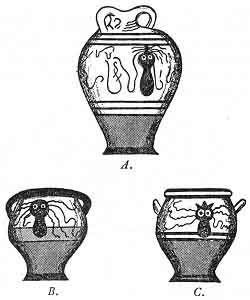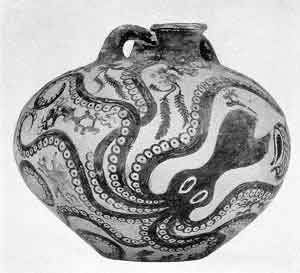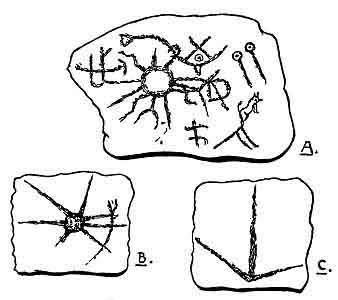Mitología del pulpo -The octopus, a sacred symbol-
Published Monday, January 31, 2005 by Spyder | E-mail this post
THE OCTOPUS, A SACRED SYMBOL
For example: the Babylonians say Belmarduk, the Sun, fights Tiamet, the Waters. From a Cuneiform Tablet-"The gods are preparing for a grand contest against the monster, Tiamet." "The god Belmarduk overthrows Tiamet." The Egyptians have it that Horus, the Sun, overcomes and kills the serpent Aphopis, the Waters. The Hindus say that Krisna, the Sun, destroyed the serpent Anatha, the Waters. And the Greeks record that Apollo, the Sun, overcomes Python, the Waters. The Fifth Command of the Sacred Writings of Mu is: "And the arrows of the Sun met the arrows of the Earth in the mud of the waters and out of particles of the mud formed cosmic eggs"--life germs.
From the foregoing, combined with the legends about the Octopus, it appears that the Octopus was the symbol of the resistance of the mud against allowing the Sun's Forces to draw the Earth's Forces out into the water to form life's cosmic eggs. The Sun's Forces, however, prevailed and met the Earth's Forces and formed cosmic eggs, and life commenced according to Divine Command.
The legends as told today about the Octopus are perfect myths, but by going behind the myth and finding its origin we discover the true legend.
It was very noticeable that wherever a legend is found the phenomenon is shown to have occurred in that particular spot. This is especially so among savage and semi-savage people. As examples: the Fijians have a legend about the "Tower of Babel." According to them the "Tower of Babel" was being built on one of the Fijian Islands. The Fijians are courteous to visitors and will take anyone gladly to the spot where it stood. The Polynesians have a legend about the "Ark." They claim that it was built on one of their islands. The Maoris have a legend about "Cain and Abel." They tell you that Cain and Abel were New Zealanders and that the murder of Abel occurred in New Zealand.
The symbolic Octopus, like the Sun, is known by many names, its name being taken from the language of the people where it is found. With all people the Octopus was a Water Demon and the Enemy of Life. It had no other meaning.
SHADOWS FROM GREECE AND ASIA MINOR.--From the ancient cities of the Grecian Archipelago and Asia Minor, which have been and are being unearthed, many pieces of pottery have been found which have the Octopus either engraved, raised or painted on them, making prominent and striking decorations. In Crete, Cyprus and Troy many fine and perfect specimens have been discovered. Fortunately, the motif designs vary considerably which gives one a fair chance to read their correct meaning, as for instance, on vases B and C in the Cyprus Group. On both the tentacles and body are intact. Here the Octopus is simply a reminder of that which it symbolizes. Vase A, from the same ruined city, shows a totally different phase. Here the Octopus is depicted as having been in battle and got the worst of the encounter. This is shown by his broken and cut tentacles, his fighting weapons.  A Group of octopus vases from Cyprus
A Group of octopus vases from Cyprus
First, the Octopus has within the grasp of one of its upper tentacles a Serpent, a specialized Serpent, an exact duplication of one of the Mound Builders' Serpent Mounds. What connection is there between the Mound Builders and the people who carved this rock picture? Were they the same people? Or was this peculiar specialized Serpent used by various peoples and was this picture etched by one of them? The Octopus, having the Serpent within the grasp of one of its tentacles, intimates that the circle from which the tentacles project is the body of the Octopus; but being a circle it is a picture of the Sun. This would suggest that the circle was a Sun symbol and not the body of the Octopus.
Second, as against reading the circle as a Sun symbol we see projecting from the lower side of the circle the beak of the Octopus in the form of the ancient symbol for a cutting or dividing Force. This symbol also appears on the Mexican tablet No. 1584, Woman's Creation. Added to this in the small Fig. B, the Octopus is shown with a real body, nearly round, with the Serpent held in one of the tentacles.
Third, the foregoing shows a possibility that the circle forming the body in Fig. A may actually be symbolizing the Sun's Forces as Kin, the Celestial orb, and not Ra, the monotheistic symbol of the Deity.
One of the difficulties in attempting to read this picture is that the ends of most of the tentacles are so indistinct that their meanings are doubtful. This picture requires a great deal of study with the assistance of other pictures referring to the same subject to obtain the full meaning in detail. The fact remains that it may convey the same meaning as the Octopus on the Cyprus Vase A and many other pictures of the Greeks, Egyptians, Hindus, Babylonians, etc.
At the lower right hand corner is shown either a wolf or a dog. In the Scandinavian myths this dog or wolf plays an important part.
THE OCTOPUS.--The Octopus is one of the very rare sacred symbols. By this I do not mean that it was seldom used, but that only a few symbols of it have been found. As a matter of fact I think it was a very common symbol among some of the ancient peoples. At present when found, generally on pottery, archaeologists have looked upon them as mere decorations and ignored the fact that many of the specimens show, without a doubt, that they were sacred symbols.
The Octopus is often found on the ancient Greek pottery. It was used in Peru, Brazil, North America, Greece and Scandinavia until a few thousand years ago. Judging by the way it was used it was the symbol of a Water Demon, the Enemy of Life. Its rôle was to prevent the advent of life on earth.
Most of the ancient writings telling about the advent of life on earth symbolize it in such a manner that it represents a battle between the Sun and the Waters for supremacy over something, but does not say what that something is.

Vase of the Late Minoan I Period (about 1600-1100 B. C.) found on Gournia, Crete Courtesy of the Metropolitan Museum of Art."
The Octopus is often found on the ancient Greek pottery. It was used in Peru, Brazil, North America, Greece and Scandinavia until a few thousand years ago. Judging by the way it was used it was the symbol of a Water Demon, the Enemy of Life. Its rôle was to prevent the advent of life on earth.
Most of the ancient writings telling about the advent of life on earth symbolize it in such a manner that it represents a battle between the Sun and the Waters for supremacy over something, but does not say what that something is.

Vase of the Late Minoan I Period (about 1600-1100 B. C.) found on Gournia, Crete Courtesy of the Metropolitan Museum of Art."
For example: the Babylonians say Belmarduk, the Sun, fights Tiamet, the Waters. From a Cuneiform Tablet-"The gods are preparing for a grand contest against the monster, Tiamet." "The god Belmarduk overthrows Tiamet." The Egyptians have it that Horus, the Sun, overcomes and kills the serpent Aphopis, the Waters. The Hindus say that Krisna, the Sun, destroyed the serpent Anatha, the Waters. And the Greeks record that Apollo, the Sun, overcomes Python, the Waters. The Fifth Command of the Sacred Writings of Mu is: "And the arrows of the Sun met the arrows of the Earth in the mud of the waters and out of particles of the mud formed cosmic eggs"--life germs.
From the foregoing, combined with the legends about the Octopus, it appears that the Octopus was the symbol of the resistance of the mud against allowing the Sun's Forces to draw the Earth's Forces out into the water to form life's cosmic eggs. The Sun's Forces, however, prevailed and met the Earth's Forces and formed cosmic eggs, and life commenced according to Divine Command.
The legends as told today about the Octopus are perfect myths, but by going behind the myth and finding its origin we discover the true legend.
It was very noticeable that wherever a legend is found the phenomenon is shown to have occurred in that particular spot. This is especially so among savage and semi-savage people. As examples: the Fijians have a legend about the "Tower of Babel." According to them the "Tower of Babel" was being built on one of the Fijian Islands. The Fijians are courteous to visitors and will take anyone gladly to the spot where it stood. The Polynesians have a legend about the "Ark." They claim that it was built on one of their islands. The Maoris have a legend about "Cain and Abel." They tell you that Cain and Abel were New Zealanders and that the murder of Abel occurred in New Zealand.
The symbolic Octopus, like the Sun, is known by many names, its name being taken from the language of the people where it is found. With all people the Octopus was a Water Demon and the Enemy of Life. It had no other meaning.
SHADOWS FROM GREECE AND ASIA MINOR.--From the ancient cities of the Grecian Archipelago and Asia Minor, which have been and are being unearthed, many pieces of pottery have been found which have the Octopus either engraved, raised or painted on them, making prominent and striking decorations. In Crete, Cyprus and Troy many fine and perfect specimens have been discovered. Fortunately, the motif designs vary considerably which gives one a fair chance to read their correct meaning, as for instance, on vases B and C in the Cyprus Group. On both the tentacles and body are intact. Here the Octopus is simply a reminder of that which it symbolizes. Vase A, from the same ruined city, shows a totally different phase. Here the Octopus is depicted as having been in battle and got the worst of the encounter. This is shown by his broken and cut tentacles, his fighting weapons.
 A Group of octopus vases from Cyprus
A Group of octopus vases from CyprusFrom where did the Greeks get the octopus? First, the octopus appears to have been one of the symbols used by Mu. From the Motherland it was taken by the Carians into Peru and Brazil. Second, when the Carians, the forefathers of the Greeks, continued their advance towards the cast and finally settled at the eastern end of the Mediterranean they carried their sacred symbols along with them and among these was the Octopus.
I think the foregoing shows sufficient proof that the Octopus was one of the early sacred symbols and that it was carried to the southeastern parts of Europe and Asia Minor by the Carians. But what people carried it to Scandinavia is an open question.
I think the foregoing shows sufficient proof that the Octopus was one of the early sacred symbols and that it was carried to the southeastern parts of Europe and Asia Minor by the Carians. But what people carried it to Scandinavia is an open question.
THE PIPESTONE OCTOPUS.--In trying to read this pictograph one apparently is met by three contradictions:
First, the Octopus has within the grasp of one of its upper tentacles a Serpent, a specialized Serpent, an exact duplication of one of the Mound Builders' Serpent Mounds. What connection is there between the Mound Builders and the people who carved this rock picture? Were they the same people? Or was this peculiar specialized Serpent used by various peoples and was this picture etched by one of them? The Octopus, having the Serpent within the grasp of one of its tentacles, intimates that the circle from which the tentacles project is the body of the Octopus; but being a circle it is a picture of the Sun. This would suggest that the circle was a Sun symbol and not the body of the Octopus.
Second, as against reading the circle as a Sun symbol we see projecting from the lower side of the circle the beak of the Octopus in the form of the ancient symbol for a cutting or dividing Force. This symbol also appears on the Mexican tablet No. 1584, Woman's Creation. Added to this in the small Fig. B, the Octopus is shown with a real body, nearly round, with the Serpent held in one of the tentacles.
Third, the foregoing shows a possibility that the circle forming the body in Fig. A may actually be symbolizing the Sun's Forces as Kin, the Celestial orb, and not Ra, the monotheistic symbol of the Deity.
One of the difficulties in attempting to read this picture is that the ends of most of the tentacles are so indistinct that their meanings are doubtful. This picture requires a great deal of study with the assistance of other pictures referring to the same subject to obtain the full meaning in detail. The fact remains that it may convey the same meaning as the Octopus on the Cyprus Vase A and many other pictures of the Greeks, Egyptians, Hindus, Babylonians, etc.
At the lower right hand corner is shown either a wolf or a dog. In the Scandinavian myths this dog or wolf plays an important part.
Colonel James Churchward -The sacred symbols of Mu-
Labels: Mitología




0 Responses to “Mitología del pulpo -The octopus, a sacred symbol-”
Leave a Reply